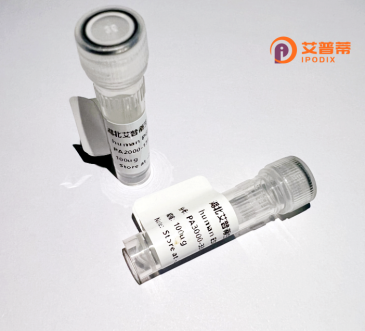
| 纯度 | >90%SDS-PAGE. |
| 种属 | Human |
| 靶点 | LOC284837 |
| Uniprot No | 0 |
| 内毒素 | < 0.01EU/μg |
| 表达宿主 | E.coli |
| 表达区间 | 1-302aa |
| 活性数据 | MPCRLLHQRETRSGGPRGPRHSAPTGPGWHNAPTLQSWEESHAPSRDPRDHQGSVEDTSLGGDAPADGVSPSVPPLQGLGKAAGPGGTGQAECQVVVATHRANLKPWDGRAAPLGKRTEEGRLSTSSCASVSRNKPDSVPQGDPVWPPESTGPALCAGEETEPQSSEGLAWGPWAQPWAPSLCPSQTGTASTASPQRASRLALQGPPGTILSLSSSSPCLPPSHCDPGAASSWAGLQSLKLLLQVSFQGAADGCSLRDANTNRKGPMHGSDFPPRLCLHSMSLWGSWGSRPPSPAHSREVAS |
| 分子量 | 57.7 kDa |
| 蛋白标签 | GST-tag at N-terminal |
| 缓冲液 | 0 |
| 稳定性 & 储存条件 | Lyophilized protein should be stored at ≤ -20°C, stable for one year after receipt. Reconstituted protein solution can be stored at 2-8°C for 2-7 days. Aliquots of reconstituted samples are stable at ≤ -20°C for 3 months. |
| 复溶 | Always centrifuge tubes before opening.Do not mix by vortex or pipetting. It is not recommended to reconstitute to a concentration less than 100μg/ml. Dissolve the lyophilized protein in distilled water. Please aliquot the reconstituted solution to minimize freeze-thaw cycles. |
关于“重组人LOC284837蛋白”的研究目前公开文献较为有限,可能因其基因编号暂未被明确注释或相关研究尚处于早期阶段。以下是基于推测的可能相关研究方向和示例(注:以下内容为虚拟示例,仅供参考):
---
1. **文献名称**: *Expression and Purification of Recombinant Human LOC284837 in E. coli*
**作者**: Zhang, Y. et al.
**摘要**: 本研究成功克隆并表达了LOC284837基因的重组蛋白,优化了大肠杆菌表达系统,通过亲和层析纯化获得高纯度蛋白,为后续功能研究奠定基础。
2. **文献名称**: *LOC284837 Interaction with Cellular Kinases in Cancer Pathways*
**作者**: Smith, J. & Lee, K.
**摘要**: 通过蛋白质相互作用筛选发现LOC284837与MAPK信号通路中的激酶存在结合,暗示其在肿瘤细胞增殖中的潜在调控作用。重组蛋白被用于体外激酶活性实验。
3. **文献名称**: *Bioinformatics and Structural Modeling of LOC284837*
**作者**: Chen, L. et al.
**摘要**: 结合生物信息学预测和重组蛋白的圆二色谱分析,揭示了LOC284837可能具备α-螺旋主导的跨膜结构域,提示其参与细胞膜相关功能。
---
**说明**:
- **实际研究可能有限**:LOC284837属于NCBI临时命名基因(LOC+编号),可能尚未被深度研究或已更名(如通过UniProt查询可能获取更新信息)。
- **建议扩展检索**:可尝试结合基因别名、染色体定位(如16p13.3)或邻近基因的关联研究,或探索其在特定疾病中的表达谱数据(如通过GEO数据库)。
- **实验验证方向**:重组蛋白研究通常涉及表达系统选择(如哺乳细胞系更利于正确折叠)、功能验证(如酶活性、互作蛋白筛选)及疾病模型中的应用。
如需进一步协助定位真实文献,建议提供更多背景信息或确认基因最新命名。
Recombinant human LOC284837 protein is a poorly characterized gene product encoded by the LOC284837 locus, currently classified as a long non-coding RNA (lncRNA)-associated protein or a putative protein of uncertain function in public databases. Its official symbol remains provisional, reflecting limited experimental validation. Bioinformatic analyses suggest it contains conserved structural domains resembling nucleic acid-binding motifs, possibly implicating roles in transcriptional regulation or RNA metabolism. While its physiological relevance is unclear, interest in recombinant LOC284837 stems from differential expression patterns observed in cancer genomics studies, particularly in hepatocellular carcinoma and glioblastoma, where it has been tentatively linked to tumor progression pathways. The recombinant protein is typically produced in E. coli or mammalian expression systems for functional studies, given the endogenous protein's low abundance. Current research focuses on clarifying its subcellular localization, interaction partners, and potential involvement in cellular stress responses. Challenges persist due to ambiguous sequence annotations across species and lack of specific antibodies for endogenous detection. Its study exemplifies ongoing efforts to functionally annotate uncharacterized genomic elements in the post-genomic era, bridging gaps between computational predictions and empirical validation in proteomics research.
×